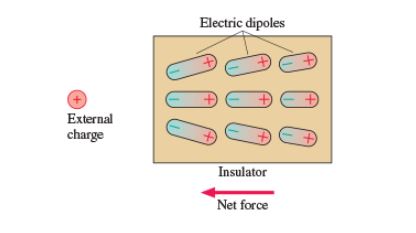Electric Dipole
Two opposite charges with a slight separation between them form an electric dipole.
A neutral atom that is polarized by an external charge forms an electric dipole.
Now, one very tricky question we have yet to answer: how does a charged rod pick up paper, which is an insulator rather than a metal? The answer lies in this concept of an electric dipole.
In an insulator, the electrons are unable to move freely and thus cannot have a sea of electrons shift. However, there is still local polarization that occurs. As a result, all the individual atoms inside the insulator, the electrons are unable to move freely and thus cannot have a sea of electrons shift. However, there is still local polarization that occurs. As a result, all the individual atoms inside the insulator become polarized. The polarization force acting on each atom produces a net polarization force toward the external charge.
